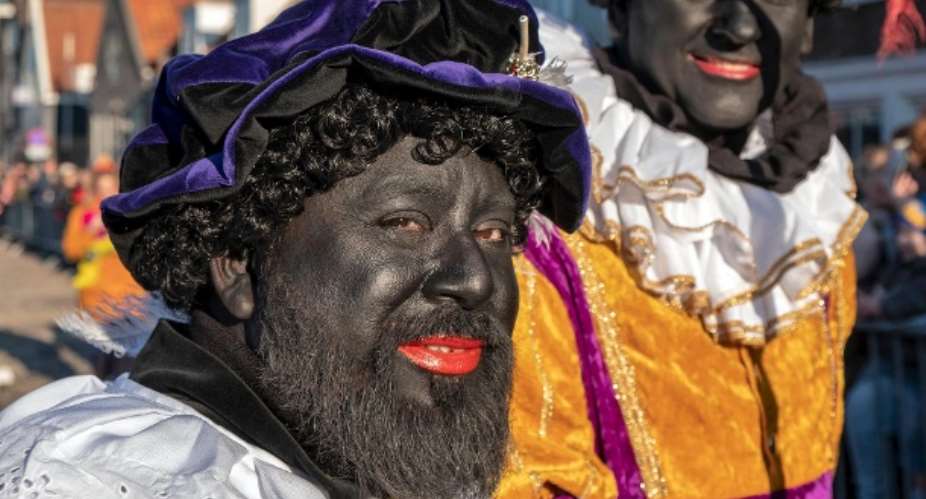In about 100 Dutch (Holland) towns the parades continue to take place with the controversial costumes. The dispute over the black-painted helpers of St. Nicholas has grown into a cultural battle in the Netherlands. This year there is a decisive innovation.
When Santa Claus arrives in the Netherlands, 90 demonstrators will be arrested in one fell swoop. Mounted policemen have to protect the bringer of gifts, sometimes the effort is greater than in a risk game of the professional football league. It may even be that the head of government intervenes and calls for peace to be maintained. The great agitator is the black servant of the Holy Man. This year, however, many things will be different.
St Nicholas is traditionally celebrated much more extensively in the Netherlands than in Germany. Already in the middle of November, three weeks before St. Nicholas Eve on 5 December, "Sinterklaas" arrives on a steamboat. You can experience its festive reception with a parade in many cities, atmospherically it moves somewhere between Rosenmontag and St. Martin.
The children love the "Zwarten Piet"
It is not St Nicholas himself who heats the spirits, it is his companion, the Dutch version of Knecht Ruprecht. Unlike the latter, the "Zwarte Piet" ("Black Peter") is not fearsome, but friendly and funny, he is the children's favourite. There is also not only one of them, but a whole entourage.
The problem is the appearance of the servants
Each Piet wears a pageboy costume with purple pants, a feather hat and golden earrings. But above all he is black: black with red lips. The many St. Nicholas songs that every child knows by heart leave no doubt about his function: he is his white master's "servant".
The criticism is not new - but it continues to spread
There has been criticism of the figure since the early 20th century, says the ethnologist Markus Balkenhol, who scientifically examined the festival. The criticism intensified as more and more people of African origin, especially from the colonies of Surinam and the Antilles who moved to the Netherlands after the Second World War. "Currently, the group of critics is becoming ever wider and more diverse," explains Balkenhol of the German Press Agency.
In addition, concepts such as 'culture' and 'tradition' have gained in importance. "The idea is that there are "people with characteristic culture", and the Sinterklaas festival is regarded as such a phenomenon and lifted up on a pedestal. It is often overlooked that different people in the Netherlands see different things in it."
It is not only a question of racism, but also of tensions between the large metropolises in the west of the country and the eastern provinces, which often feel ignored. Some wanted to give the festival back its original Catholic character, others want it to have no religious references, so that all children can feel equally addressed.
Dutch television has now found a compromise
This year something important will change: For the first time on Dutch television there will be no more "black rivets", only "soot spot rivets". These are white rivets with a few black spots on their faces - soot from the chimneys through which they abseil the gifts.
The black-painted version disappears both from the popular "Sinterklaas News" and from the live broadcast "National Entry", which takes place this year on Saturday (16 November) in Apeldoorn. A complaint against the disappearance of the "Black Pieten" from the move was dismissed last Thursday by a court in Arnhem. The Piet-Kritiker celebrate this as large success.
Fewer and fewer Dutch people wish for the black make-up
A survey published in December 2018 showed that every second Dutchman is in favour of the "Black Piet" remaining black. Just two years earlier, that was 65 percent. For an adjustment of the figure are above all well educated and rather left-wing Dutchmen.
According to a survey published on Friday by the newspaper "NRC Handelsblad", one in three Dutch citizens now lives in a place where "Russflecken-Pieten" (soot stains) are running along with St. Nicholas's procession. However, there is still no end in sight to the dispute, around 1,000 St. Nicholas removals throughout the country continue to rely on traditional rivets, as black as possible.
Francis Tawiah (Duisburg - Germany)





 Minority will expose the beneficial owners of SML, recover funds paid to company...
Minority will expose the beneficial owners of SML, recover funds paid to company...
 Prof. Opoku-Agyemang has ‘decapitated’ the NPP’s strategies; don’t take them ser...
Prof. Opoku-Agyemang has ‘decapitated’ the NPP’s strategies; don’t take them ser...
 Abubakar Tahiru: Ghanaian environmental activist sets world record by hugging 1,...
Abubakar Tahiru: Ghanaian environmental activist sets world record by hugging 1,...
 Prof. Naana Opoku-Agyemang will serve you with dignity, courage, and integrity a...
Prof. Naana Opoku-Agyemang will serve you with dignity, courage, and integrity a...
 Rectify salary anomalies to reduce tension and possible strike action in public ...
Rectify salary anomalies to reduce tension and possible strike action in public ...
 Stop all projects and fix ‘dumsor’ — Professor Charles Marfo to Akufo-Addo
Stop all projects and fix ‘dumsor’ — Professor Charles Marfo to Akufo-Addo
 Blue and white painted schools will attract dirt shortly – Kofi Asare
Blue and white painted schools will attract dirt shortly – Kofi Asare
 I endorse cost-sharing for free SHS, we should prioritise to know who can pay - ...
I endorse cost-sharing for free SHS, we should prioritise to know who can pay - ...
 See the four arsonists who petrol-bombed Labone-based CMG
See the four arsonists who petrol-bombed Labone-based CMG
 Mahama coming back because Akufo-Addo has failed, he hasn't performed more than ...
Mahama coming back because Akufo-Addo has failed, he hasn't performed more than ...
